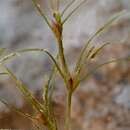Biology
provided by Arkive
The slender naiad is eaten by waterfowl and provides shelter for aquatic insects and small fish (2). It can reproduce sexually through seeding as well as through vegetative reproduction (2). Flowering and fruiting occur from August to September; the male and female parts are found on the same plant but in separate flowers (5). Pollination occurs underwater as the plant is completely submerged, although floating fragments are often found (2).
Conservation
provided by Arkive
Conservation of this species is underway. Scottish National Heritage carried out surveys in 1994 and 1995 and the number of known Scottish sites that are home to the slender naiad was increased from 24 to 34. There has also been extensive assessment of known populations with a view to maintaining them through water quality control and by limiting local area farming and forestry operations to reduce run-off. Three Sites of Special Scientific Interest house populations and these have been put forward for Special Area Conservation plans under the EC Habitats Directive. There are plans to assess the condition of sites which used to include the slender naiad and to reintroduce plants if possible. Northwest Water have been directed to investigate better sewage treatment options and the Royal Botanic Gardens at Edinburgh and Kew are responsible for collecting valuable seed to add to the Millennium Seed Bank. Finally, studies of the population dynamics and habitat requirements of the slender naiad will be undertaken so that projects to maintain and restore populations have a higher success rate (4).
Description
provided by Arkive
This slender, flexible plant has a branched stem with long, narrow leaves which are oppositely positioned at the bottom of the plant but become clustered and whorled towards the tips. The slender naiad has inconspicuous fruits and flowers under the leaves (2).
Habitat
provided by Arkive
This aquatic plant is found in clear, lowland water bodies such as ponds, lakes, slow-moving streams, heathland pools and canals with low to medium levels of plant nutrients, (2) (3). It can grow in areas with limestone geology, resulting in water rich in lime, and can even tolerate brackish water (4). The water must be between one and four metres deep (2) (4).
Range
provided by Arkive
The slender naiad is now limited to Scotland in the UK and is most commonly found on western coast islands. It was previously present in the Lake District in England but despite surveys taking place, there has been no record of it in England since 1982 (3) (4). Outside the UK, the slender naiad is present in Ireland, northern Europe and northern North America (2) (3) (4).
Status
provided by Arkive
This species is listed under Annexes II and IV of the EC Habitats Directive and Appendix I of the Bern Convention, as well as being protected under Schedule 4 of the Conservation Regulations 1994 and Schedule 8 of the Wildlife and Countryside Act 1981 (4).
Threats
provided by Arkive
Nutrient-rich run-off from fish farms, agricultural farms and forestry operations cause an increase in nutrient-loving algae and plants, which compete with the slender naiad for space and light, restricting its growth (4).

